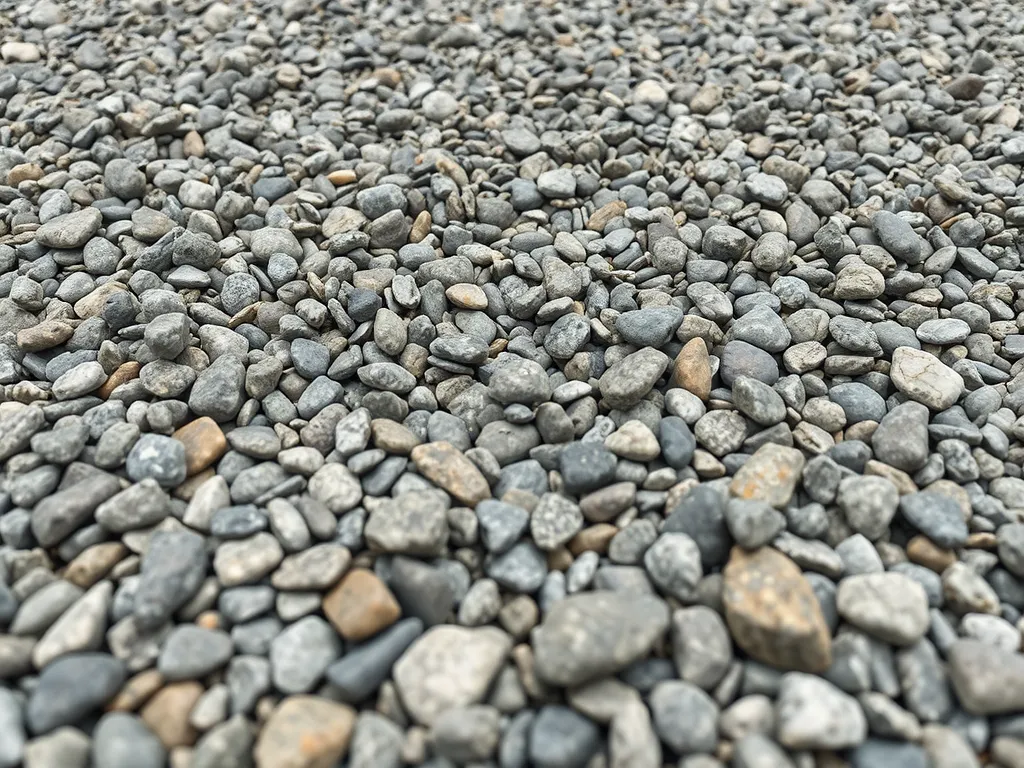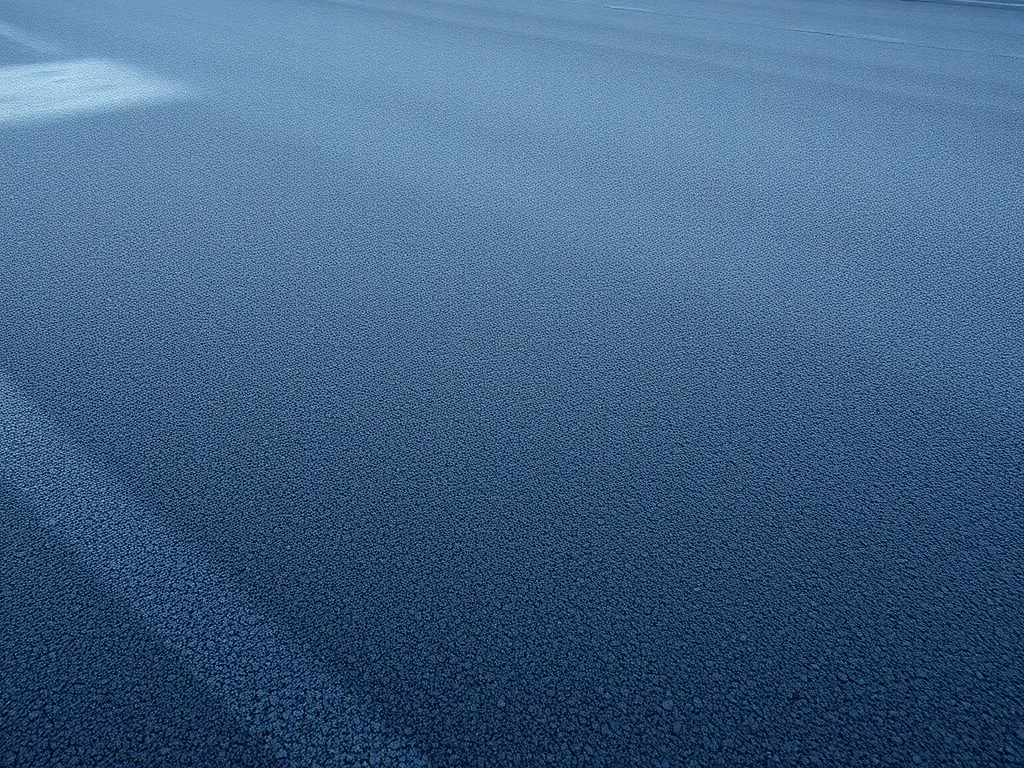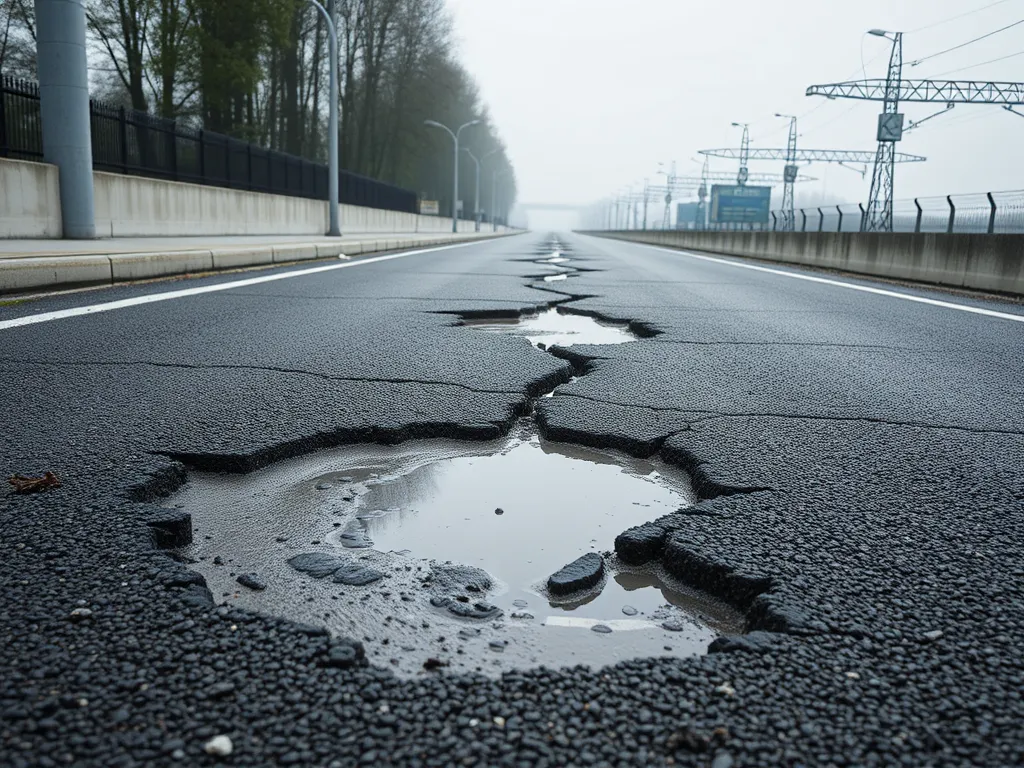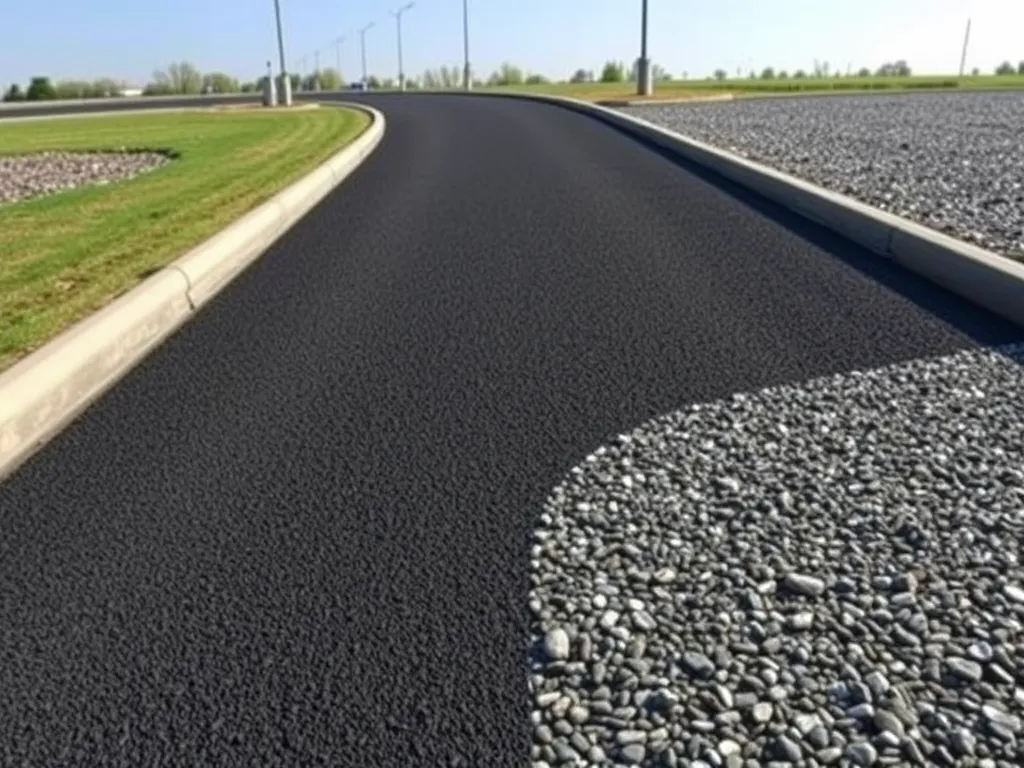Can You Asphalt Over Gravel? Feasibility, Process, and Considerations
Published on: October 3, 2025 | Last Updated: April 14, 2025
Written By: George Voss
Yes, you can install asphalt over gravel if the existing base is stable and properly prepared. This method involves evaluating gravel quality, compacting it to 95% Proctor density (a measure of soil stability), and addressing drainage needs. Benefits include saving 30-50% compared to full gravel removal and creating a durable surface that lasts 15-20 years. Drawbacks include potential cracking if the base shifts or drains poorly. Always hire a licensed contractor to assess your site. Costs average $3-$7 per square foot for materials and labor.
This article covers how to determine if your gravel base can support asphalt, steps for proper installation, and cost-saving strategies. Learn which gravel types work best, why thickness matters, and how to avoid common errors like poor compaction or inadequate slope. We’ll break down material choices, environmental impacts, and maintenance routines to maximize your pavement’s lifespan.
Contents
- Is Asphalt Over Gravel Feasible?
- Why Gravel is Critical for Asphalt Driveways
- Preparing a Gravel Base for Asphalt
- Asphalt Installation Process Over Gravel
- Benefits Of Asphalting Over Gravel
- Drawbacks Of Laying Asphalt Over Gravel
- Cost to Convert Gravel Driveway to Asphalt
- Environmental and Maintenance Considerations
- FAQs About Asphalt Over Gravel
- Closing Thoughts
- Additional Resources for You:
Is Asphalt Over Gravel Feasible?
Asphalt paving over gravel works when existing gravel meets structural standards. Success depends on base quality, material composition, and site preparation. Over 60% of residential driveways use gravel bases under asphalt when properly installed.
Key Factors for Successful Asphalt Over Gravel Installation
Three elements determine whether laying asphalt over gravel succeeds:
- Base thickness: Minimum 4-6″ compacted gravel layer (crushed angular stone preferred)
- Compaction density: 95% Proctor density verified with nuclear density tests
- Drainage slope: 2% minimum grade to prevent water pooling under pavement
Use #57 or #411 crushed stone aggregates (3/4″ to dust mix) for optimal load distribution. Geotextile fabrics add stability on clay soils.
When Asphalt Over Gravel is Not Recommended
Avoid asphalt on gravel when these red flags appear:
- Less than 3″ of existing gravel depth
- Visible organic matter or topsoil mixed into base
- Standing water after rains or wheel ruts deeper than 1″
Subgrade failures in these scenarios cause asphalt cracks within 12-18 months. Full excavation becomes necessary when base contamination exceeds 15% by volume.
Proper base prep makes asphalt driveway over gravel installations last 20+ years. Next, let’s examine why gravel remains fundamental to asphalt performance.
Why Gravel is Critical for Asphalt Driveways
Gravel provides the structural backbone for lasting asphalt surfaces. Without it, even properly mixed paving materials fail prematurely under traffic loads or freeze-thaw cycles. The right gravel base distributes weight, resists shifting, and keeps water moving away from the surface.
Role Of Gravel As a Base Layer Under Asphalt
Gravel acts like a shock absorber between the soil and asphalt. It prevents the pavement from sinking into soft ground by spreading vehicle weight across a wider area. This crushed stone layer also stops water from pooling under the asphalt, which reduces cracking caused by frost heave. For optimal performance, the base must compact to 95% density using vibratory rollers. A 6-8 inch gravel layer is standard for residential driveways handling passenger vehicles.
Best Gravel Types and Sizes for Asphalt Bases
Not all gravel works under asphalt. Angular crushed stone like #57 (3/4” to 1.5”) or #411 (mixed with stone dust) locks together tightly when compacted. Avoid rounded river rock – it shifts under pressure. Washed gravel with less than 5% fines prevents clay buildup that weakens bases. In freeze-prone regions, add 2-3 inches of smaller #8 stone for better drainage. Contractors often pair these with geotextile fabrics to separate soil from gravel.
Proper gravel selection sets the stage for successful paving. Next, we’ll break down how to prep your existing gravel base for fresh asphalt.

Preparing a Gravel Base for Asphalt
A strong gravel foundation is vital for long-lasting asphalt. Skipping this step risks cracks, dips, or washouts within months. Follow this three-part plan to build a base that handles traffic loads and weather shifts.
Step 1: Assessing Existing Gravel Conditions
Start by checking your gravel’s depth and quality. Push a rod into the ground—if it hits soil before 4 inches down, add more gravel. Look for soft spots with standing water or sinking zones. Gravel must consist of angular stones (like #304 or #411) that lock tight, not smooth river rock. Remove any organic material or clay lumps mixing with your gravel.
- Minimum gravel depth: 4 inches for foot traffic, 8-12 inches for cars
- Top picks: Road-grade crushed stone with 1.5-2.5 tons per cubic yard density
- Red flags: Ruts >1 inch deep, >15% fine particles passing a #200 sieve
Step 2: Compaction Requirements for Stability
Loose gravel shifts under asphalt, causing cracks. Use a vibratory roller (1,500-2,500 lbs) in 2-inch layers, making 4-6 passes per section. Aim for 95% Proctor density—a lab test measuring maximum dry unit weight. For DIY jobs, a hand tamp works but can’t match professional results. Check compaction by walking the area; footprints shouldn’t sink >1/4 inch.
- Optimal moisture: 5-7% by weight for binding without mud
- Tools: Plate compactor (rental: $75/day), laser-guided graders for slopes
- Test method: Sand cone kit ($120) verifies in-field density
Step 3: Ensuring Proper Drainage Design
Water pooling under asphalt causes frost heave and base failure. Build a 2% slope away from structures—a 1/4-inch drop per foot. For driveways, crown the center at 1/4 inch per foot to shed rain. Install French drains along low spots using perforated PVC pipes wrapped in fabric. Add catch basins if grading can’t fix pooling.
- Slope tools: Rotary laser level ($300) or string line with line level ($15)
- Drainage fix: 4-inch aggregate layer below gravel for frost protection
- Warning: Avoid flat zones—standing water cuts asphalt lifespan by half
With a compacted, well-draining base, your asphalt will hold strong for 15-20 years. Up next: how hot-mix application and thickness choices impact final results.
Also See: Cold Mix Asphalt for Commercial Parking Lots: An Efficient Choice
Asphalt Installation Process Over Gravel
Converting a gravel surface to asphalt requires precise techniques. Proper execution ensures the new pavement bonds with the gravel base and resists shifting. Let’s break down critical installation steps.
Optimal Thickness for Asphalt Over Gravel
Residential driveways need 2-3 inches of asphalt over gravel. Commercial areas with heavier traffic require 3-4 inches. Thin layers under 2 inches crack faster due to insufficient load distribution. For driveways with poor drainage or soft soil, increase thickness by 0.5-1 inch. Contractors typically use Type C or D asphalt mixes (rated for 3,000-10,000 psi) based on climate and usage.
| Application | Minimum Thickness | Asphalt Type |
|---|---|---|
| Residential Driveways | 2-3 inches | Type C |
| Parking Lots | 3-4 inches | Type D |
Applying Hot-mix Asphalt Layers
Hot-mix asphalt (HMA) heated to 275-300°F is poured directly onto prepared gravel. Spreaders create even layers, followed by steel-drum rollers compacting the mix. Two lifts (layers) are standard: a 1.5-inch base layer and a 1.5-inch finish layer. For better bonding, contractors apply a tack coat (asphalt emulsion) between layers if adding fresh asphalt over existing pavement edges.
Sealcoating for Longevity
Sealcoating protects asphalt over gravel driveways from UV rays and water penetration. Apply the first coat 6-12 months after installation, then every 3-5 years. Coal-tar-based sealants last longer (4-5 years) than asphalt-emulsion types (2-3 years). Costs average $0.15-$0.25 per square foot. Properly sealed surfaces reduce cracks by 60-70% compared to unsealed ones.
While thickness and sealing boost durability, the benefits of asphalt paving over gravel extend beyond surface quality. Next, we explore how this method saves money while enhancing performance.

Benefits Of Asphalting Over Gravel
Opting to install asphalt on top of a gravel subbase brings practical upsides for both budget and functionality. This tactic skips full gravel disposal, saving cash and labor while building a sturdy driving surface.
Cost-saving Alternative to Full Disposal
Laying asphalt paving over gravel cuts costs by 30-50% versus digging out old material. No hauling fees or landfill charges apply. Contractors typically bill $3-$5 per sq. ft. for asphalt over gravel vs. $7-$10+ for total base rebuilding. Savings jump higher if original gravel has good compaction—no need for costly machinery beyond a vibratory roller.
Boosted Strength and Riding Quality
A solid gravel layer under asphalt stops rutting and alligator cracks. When compacted to 95% Proctor density, angular stones like ¾” crushed rock lock into a grid that spreads vehicle loads. Hot-mix asphalt (HMA) at 2.5”-3” thickness bonds tightly to this base, forming a smooth mat that lasts 15-20 years with annual sealcoating. Proper drainage slopes (2-3%) stop water from pooling—a key reason why 90% of roads in the U.S. use gravel-asphalt builds.
But not all outcomes hit the mark. Up next: what can go wrong when mixing asphalt with gravel bases.
Drawbacks Of Laying Asphalt Over Gravel
While installing asphalt over gravel saves time versus full removal, this method introduces specific risks requiring careful evaluation. Structural weaknesses and environmental factors can compromise results if not addressed.
Risk Of Uneven Surfaces and Cracking
Gravel naturally shifts under weight loads. Asphalt placed directly on gravel without proper prep settles unevenly, creating dips or humps within 6-12 months. Cracks form 3x faster compared to projects using graded aggregate bases. Common issues:
- Alligator cracking from poor load distribution
- Edge cracks due to lateral gravel movement
- Rutting exceeding 1″ depth under vehicle tires
Compaction matters: Gravel bases need 95% Proctor density to prevent settling. Most existing driveways only achieve 80-85% without professional equipment.
Drainage Challenges and Subbase Weaknesses
Gravel’s permeability (typical 1,000-3,000 inches/hour) allows water to seep into the subbase. Over time, this erodes fines, creating voids under asphalt. Freeze-thaw cycles expand these gaps, leading to potholes. Solutions like 2% slope crowning or French drains add $3-$7 per sq ft but remain vital for longevity.
Washed gravel (less than 5% fines) worsens drainage issues. Contractors often recommend adding 4-6″ of crushed limestone (CA6 or CA7 grades) as a stabilizing layer at $15-$25 per ton.
Weighing these factors helps determine whether overlaying asphalt meets your needs. Next, let’s break down project costs for different scenarios.

Cost to Convert Gravel Driveway to Asphalt
Converting gravel to asphalt costs $5-$12 per square foot nationally. Prices vary based on driveway size, existing gravel quality, and regional material rates. Proper prep work and asphalt thickness directly impact total expenses.
Material and Labor Cost Breakdown
Material costs for asphalt paving over gravel average $3-$7/sq ft for hot-mix asphalt (HMA). Labor runs $2-$5/sq ft for professional crews. Key cost components:
| Component | Cost Range |
|---|---|
| Site preparation | $0.50-$1.50/sq ft |
| Base gravel (if added) | $0.80-$2.00/sq ft |
| Asphalt layers | $2.50-$4.50/sq ft |
| Sealcoating | $0.15-$0.25/sq ft |
Existing gravel bases needing reinforcement add $1,000-$3,000 for extra crushed stone. Driveways requiring drainage fixes see 15%-25% higher costs. 1,000 sq ft projects typically total $7,500-$12,000 with professional installation.
DIY Vs. Professional Installation Costs
DIY asphalt on gravel driveway projects cost 25%-40% less but require specialized equipment. Renting a vibratory roller ($200/day) and maintaining HMA at 300°F during application proves challenging for non-professionals.
Professional crews guarantee 95% compaction rates (minimum 92 PSI) and include 3-5 year warranties. Contractor quotes bundle:
- Gravel base inspection
- Asphalt thickness calculations (2.5″-3″ minimum)
- Slope grading (1%-2% pitch recommended)
Improper DIY installations on gravel bases cause premature cracking in 60% of cases according to NAPA studies. Budget $1,200-$2,500 for professional sealcoating every 3-5 years post-installation.
While initial costs matter, long-term performance hinges on proper techniques. Let’s examine how environmental factors influence asphalt over gravel projects.
Environmental and Maintenance Considerations
Laying asphalt over gravel affects both eco-impact and long-term upkeep. Let’s break down key factors.
Impact Of Gravel Recycling on Sustainability
Reusing existing gravel cuts mining needs by 40-60%. This saves 2-3 tons of new rock per 100 sq ft. Crushed stone under asphalt can contain 30-50% recycled content like RAP (Recycled Asphalt Pavement). RAP blends old pavement chunks into fresh mix, trimming costs by $1.50-$3 per sq ft.
| Practice | Eco-Benefit | Cost Per Sq Ft |
|---|---|---|
| Gravel reuse | Less quarry waste | $0.20-$0.50 |
| RAP mixes | Lower emissions | $1.10-$1.80 |
Routine Maintenance for Asphalt Over Gravel
Seal cracks wider than ¼ inch quickly. Use rubberized filler to block water from reaching the gravel base. Sealcoat every 3-5 years with coal-tar or asphalt-based sealer ($0.15-$0.25 per sq ft). Check drainage slopes yearly – aim for 2% grade to move water off fast.
- Fix potholes: Remove loose gravel, pack cold patch asphalt
- Edge care: Stop gravel spread with concrete curbs
- Weight limits: Keep trucks over 10 tons off residential driveways
Proper care extends asphalt life over gravel to 20+ years. Now let’s answer your top questions about installation specs.

FAQs About Asphalt Over Gravel
How Thick Should Asphalt Be Over Gravel?
For residential driveways, asphalt should be laid at a thickness of 2-3 inches, while commercial areas may require 3-4 inches to handle heavier traffic. A thickness below 2 inches is not recommended, as it can lead to faster cracking due to inadequate load distribution.
Is Gravel a Good Base for Asphalt?
Yes, gravel serves as an excellent base for asphalt, provided it is well-compacted and properly prepared. A stable gravel layer helps distribute weight, prevents shifting, and aids in drainage, all of which are crucial for a durable asphalt surface.
Can You Pave Asphalt Directly on Top Of Gravel?
While it is possible to pave asphalt directly over gravel, the success of this method depends largely on the condition of the existing gravel. If the gravel base is compacted and stable, asphalt can be applied effectively. However, proper preparation, including assessment of the gravel conditions and ensuring adequate drainage, is essential to avoid future issues.
What is the Cost to Convert a Gravel Driveway to Asphalt?
The cost to convert a gravel driveway to asphalt typically ranges from $5 to $12 per square foot. Factors influencing the total cost include the size of the driveway, the quality of the existing gravel, and any required site preparation or drainage improvements. On average, converting involves a significant reduction in expenses compared to complete gravel removal.
Closing Thoughts
Deciding to asphalt over gravel can be a practical solution for many homeowners. It offers a cost-effective means of upgrading a driveway while improving appearance and durability. The key lies in proper preparation, ensuring a stable gravel base, and applying the right thickness of asphalt.
Keep in mind the importance of regular maintenance to extend the life of your asphalt surface. Address any drainage issues promptly to prevent future complications, and consider sealing to protect your investment.
For detailed guidance, project estimations, and more on all things asphalt, check out Asphalt Calculator USA. Your next asphalt project is just a click away!
Additional Resources for You:
- The Asphalt Institute (Technical Resources & Standards)
- gravel rolled into asphalt – Civil/Environmental engineering general discussion | Eng-Tips
- Asphalting a gravel driveway. How badly am I being taken?
- Gravel Driveway Cost | Cost to Build Gravel Driveway | Fixr
- Let’s Talk Driveways: Anyone have crushed asphalt millings?| Grassroots Motorsports forum |


